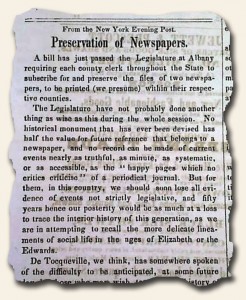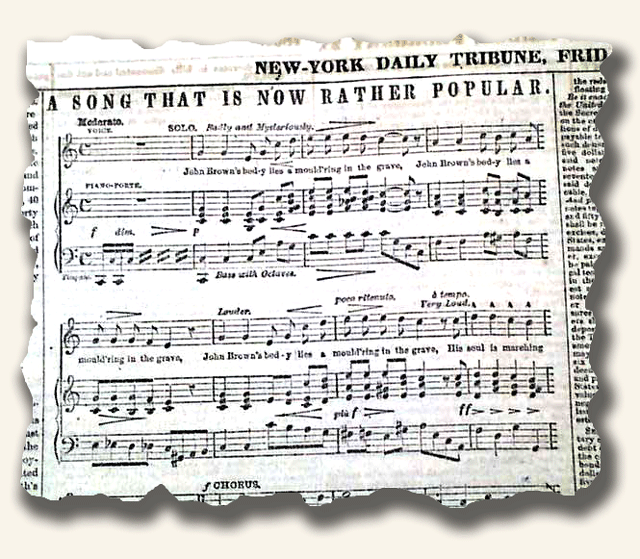Concern for preserving newspapers in 1849…
September 11, 2012 by TimHughes · 1 Comment
 Over 160 years ago the New York legislature had the foresight to be concerned about the future holdings of newspapers, and more importantly the loss of the unique perspective of history which can only be obtained through newspapers of the day. Their cause remains as relevant today as it was in 1849.
Over 160 years ago the New York legislature had the foresight to be concerned about the future holdings of newspapers, and more importantly the loss of the unique perspective of history which can only be obtained through newspapers of the day. Their cause remains as relevant today as it was in 1849.
The photos show the entire editorial as found in the “Vermont Chronicle” of Windsor, May 2, 1849, but portions include: “…No historical monument that has ever been devised has half the value for future reference that belongs to a newspaper, & no record can be made of current events nearly as truthful, as minute, as systematic, or as accessible, as the ‘happy pages which no critics criticise’ of a periodical journal…” and “…De Tocqueville…has somewhere spoken of the difficulty to be anticipated at some future day of those who may wish to trace the history of our people for the want of durable monuments or records of their current life & achievements…that the newspaper was almost our only historical repository & that was usually destroyed as soon as its contents were glanced at…” and much more.
A fascinating article on the need to preserve newspapers; something which all of us in this hobby continue to do in some small way.
The entire text of this intriguing article may be viewed at: “Vermont Chronicle” of Windsor, May 2, 1849
Collecting spurs research, spurs “neat stuff”…
December 26, 2008 by TimHughes · 1 Comment
As all of you know reading old newspapers can provide an interesting perspective on history, and cause one to question what we remember from history class of long ago. And with the advent of the internet, verifying some “facts” as reported 100+ years ago can lead to even more intriguing footnotes to history which we’d otherwise miss.
One interesting tidbit came to light earlier today and is worth sharing. The NEW YORK TRIBUNE of Feb. 28, 1862 includes on the backpage a printing of the words and music with a heading: “A Song That Is Now Rather Popular”. I recognize the music as the “Battle Hymn of the Republic”, and was aware of the lyrics which began: “John Brown’s body lies a mould’ring in the grave…” and of course the well known chorus (see photos). I was also aware that Julia Ward Howe wrote the words to “Battle Hymn…” but a website provided an interesting backdrop:
 “In 1861, after a visit to a Union Army camp, Julia Ward Howe wrote the poem that came to be called “The Battle Hymn of the Republic.” It was published in February, 1862, in The Atlantic Monthly.
“In 1861, after a visit to a Union Army camp, Julia Ward Howe wrote the poem that came to be called “The Battle Hymn of the Republic.” It was published in February, 1862, in The Atlantic Monthly.
Howe reported in her autobiography that she wrote the verses to meet a challenge by a friend, Rev. James Freeman Clarke. As an unofficial anthem, Union soldiers sang “John Brown’s Body.” Confederate soldiers sang it with their own version of the words. But Clarke thought that there should be more uplifting words to the tune.
Howe met Clarke’s challenge. The poem has become perhaps the best-known Civil War song of the Union Army, and has come to be a well-loved American patriotic anthem.”
Equally as interesting was another site concerning the “John Brown” mention, which I always presumed to be a reference to John Brown of Harper’s Ferry fame. Apparently not so:
“During a visit to Washington in the autumn of 1861, poet Julia Ward Howe attended a public parade and review of Union troops. On her way back to Willard’s Hotel she found her carriage delayed by marching regiments. To spend some time, she and her cohorts in the carriage sang a few of the war songs so popular those days, among them, “John Brown’s Body,” which contained the provocative words, “John Brown’s body lies-a-mouldering in the ground…. His soul is marching on.”
Howe would have assumed that the John Brown of the song was the famous abolitionist. But the song belonged to a young Scotsman in the Massachusetts Volunteer Militia who shared Brown’s name.
The Scotsman was well aware of John Brown the abolitionist. Having the same name made him a prime target for many good-natured jokes. As the soldiers marched, they would hammer out, in folk-song fashion, the tune that Julia Ward Howe would later hear. Lines like “His Soul’s Marching On” were meant to tease the Scotsman. But as the catchy verse traveled to other units, it was known only as a song about the John Brown who was captured at Harpers Ferry. New verses were constantly added:
Old John Brown’s body is a-mouldering in the dust,
Old John Brown’s rifleís red with blood-spots turned to rust,
Old John Brown’s pike has made its last, unflinching thrust,
His soul is marching on!
The morning after hearing the song, Julia Ward Howe wrote her own words to the tune. Soon after, it was published in the “Atlantic Monthly” as “The Battle Hymn of the Republic.”
John Brown the Scotsman would not live to hear this version. He died early in the war, drowned in the Shenandoah River at Front Royal, Virginia.”
Just a few of the interesting tidbits of history one learns by reading old newspapers!


